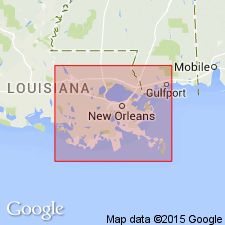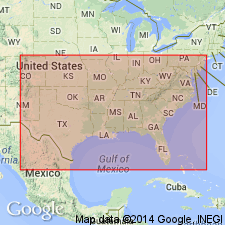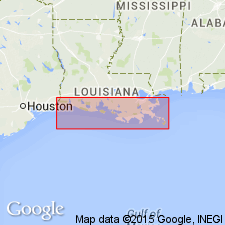
- Usage in publication:
-
- Napoleonville stage
- Modifications:
-
- Original reference
- Biostratigraphic dating
- AAPG geologic province:
-
- Gulf Coast basin
Summary:
Pg. 241, 242 (fig. 1), 243. Napoleonville stage. A stage name, based on faunal assemblages occurring in sediments commonly termed "Upper" Miocene in subsurface of southeastern Louisiana. Applied to sediments occurring between top of BIGENERINA A zone and top of BIGENERINA 2 zone. Generally, best foraminiferal markers for this stage are (descending) BIGENERINA (A) "FLORIDANA," AMPHISTEGINA E, BIGENERINA (B) "FLORIDANA var.," DISCORBIS 12, and TEXTULARIA (L) ARTICULATA (SPRIOPLECTAMMINA BARROWI). Clovelly and Duck Lake stages proposed as replacements for "Lower" and "Middle" Miocene respectively. Names were selected arbitrarily only because denoted fields demonstrate representative sections for each; nothing in way of principal producing horizons is implied.
Named from Napoleonville field, Assumption Parish, southeastern LA.
Source: Publication; US geologic names lexicon (USGS Bull. 1200, p. 2683).

- Usage in publication:
-
- Napoleonville stage
- Modifications:
-
- Areal extent
- AAPG geologic province:
-
- Gulf Coast basin
Summary:
Pg. 412-416. Napoleonville stage. Includes all beds that immediately overlie the Anahuac stage (see Akers and Drooger, 1957, AAPG Bull., v. 41, no. 4, p. 658-768; McLean, 1957) and that can be shown to be reasonably demonstrated as equivalent in age to the type section in wells in the Napoleonville field, Assumption Parish, Louisiana, or its equivalents. Characterized by assemblage zone containing the following foraminiferal species or equivalents (citing Akers and Drooger, 1957, AAPG Bull., v. 41, no. 4, p. 658-768; McLean, 1957): RECTOWIGERINA FREDSMITHI, PLANULINA PALMERI, SIPHONINA DAVISI, MARGINULINA ASCENSIONENSIS, DISCORBIS BOLIVARENSIS or ROBULUS CHAMBERSI.
Source: Publication.

- Usage in publication:
-
- Napoleonville Stage
- Modifications:
-
- Not used
- AAPG geologic province:
-
- Gulf Coast basin
Summary:
Napoleonville Stage of Murray (1961) can only be applied to strata in very narrow belts within the Gulf of Mexico [now called Gulf of America] due to problems presented by the temporal and spatial stratigraphic distribution of the characteristic benthonic neritic species. Author proposes his own subdivisions of the Miocene (divisions J to A, ascending), based on established biostratigraphic (benthic forams) correlations of regional transgressive marine units. Napoleonville Stage of Murray (1961) = (ascending) divisions J through H of author (SIPHONINA DAVISI zone to top of ROBULUS CHAMBERSI zone).
[Gulf of Mexico renamed Gulf of America (U.S. Board on Geographic Names per Presidential Executive Order 14172, issued January 20, 2025, and Department of Interior's Secretarial Order 3423, issued Feb. 7, 2025).]
Source: Publication; LA State Geol. Survey (written commun., Mar. 2007).
- Usage in publication:
-
- Napoleonville Stage
- Modifications:
-
- Overview
- AAPG geologic province:
-
- Gulf Coast basin
GNC Staff, 2007, [U.S. Geologic Names Committee remarks on names applied to Miocene sediments in subsurface of southern Louisiana]: U.S. Geological Survey, unpublished Geologic Names Committee note
Summary:
In some reports discussing Miocene sediments in the subsurface of southern Louisiana, the names Clovelly Formation, Duck Lake Formation (a name applied by Doering, 1958, to a Pleistocene subsurface unit in same area) and Napoleonville Formation have been misapplied to the biostratigraphically-defined Clovelly Stage, Duck Lake Stage, and Napoleonville Stage of McLean (1957).
Source: Louisiana State Geol. Survey (written commun., Mar. 2007).
For more information, please contact Nancy Stamm, Geologic Names Committee Secretary.
Asterisk (*) indicates published by U.S. Geological Survey authors.
"No current usage" (†) implies that a name has been abandoned or has fallen into disuse. Former usage and, if known, replacement name given in parentheses ( ).
Slash (/) indicates name conflicts with nomenclatural guidelines (CSN, 1933; ACSN, 1961, 1970; NACSN, 1983, 2005, 2021). May be explained within brackets ([ ]).

